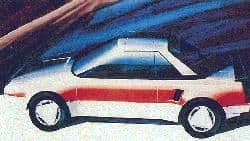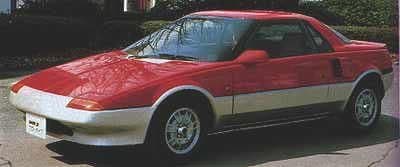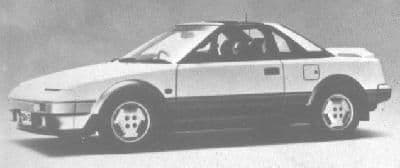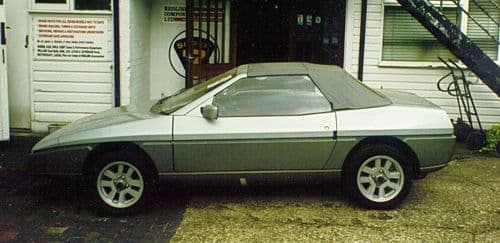History
Also refer to a brief MR2 history, and Changes by Year.
SA-X: The First Prototype
The MR2’s life began in 1976 when Toyota launched a design project with the goal of producing a car which would be enjoyable to drive, yet still, provide decent fuel economy. Initially, the purpose of the project was not a sports car. After three year delay, partially caused by the oil crisis, the actual design work began in 1979 when Akio Yoshida from Toyota’s testing department started to evaluate different alternatives for engine placement and drive method. It was finally decided to place the engine transversely in the middle of the car.

From its base design, the car began evolving into an actual sports car, and further prototypes were tested intensely both in Japan and in California. A significant amount of testing was performed on actual race circuits such as Willow Springs, where former Formula One driver Dan Gurney tested the car.
While recognizable even from the first sketch, the car was to go through many changes until the first actual prototype in 1981, the SA-X.

The Toyota SV-3
Toyota made its SV-3 concept car public in the autumn of 1983 at the Tokyo Motor Show, gathering a huge amount of publicity both from the press and the audience. The car, scheduled to be launched in spring 1984 in the Japanese market under the name MR2 was to become the first mass-produced mid-engined car to come from a Japanese manufacturer.

Taken at the Japan Motor Show
Fred Watkins (mail-group) gives the following extra info on the birth of the MR2:
I followed the development of the MR2 from the first spy composite drawing in 1983.
The MR2 was conceived in meetings in the mid-1970s as a fuel-efficient drivers car that would be driven by people who enjoyed driving regardless of regulations or gas shortages. At the time this product wasn’t even a sports car, much less mid-engined.
Around 1980 or 1981, Seiichi Yamauchi who managed Toyota’s design department, was given the project SV3. FWD, RWD, and mid-engine configurations were all studied, and in the end, the mid-engine layout initially suggested by Akio Yoshida (of Toyota’s testing department) was chosen and Yoshida was appointed head of planning for the project.
The SV3 was developed primarily as a commuter car for the individual and not the family. If you had to commute with 1 or 2 people, why not have fun. So Yoshida added the sports nature to the project. I suppose this would qualify Yoshida as the “Father of the MR2”.
Dan Gurney tested the car as a consultant at Willow Springs in California in 1983 and made suggestions to improve handling, some made at the track and analyzed at the time. A short time later, Gurney drove the vehicle on the Angeles Crest Hwy to analyze road driving. Toyota took 5 months to implement what was learned and then Gurney went to Japan to do a follow-up test and found an improved, well-balanced sports car. Remember Dan Gurney was the factory-backed Toyota race team owner during this period.
During this time Toyota had bought into Lotus as a means of gaining performance and small production run knowledge. Lotus was developing the front engine, rear drive M90 and was developing the car around the 4AGE. Toyota left Lotus soon after GM also entered into a financial partnership with Lotus.
The Fiero debuted as a 1984 model in the US, and the MR2 debuted as a 1985 model. One soared and the other soured. The 4AGE engines were manufactured in the Shimoyama plant where the parts were milled, assembled, and run on a dyno for 15 minutes to pass in-house quality tests. The MR2 was assembled in the Central Motor Company plant in Sagamihara, a plant started by retiring Toyota workers who wanted to keep working.
Rumours
The Lotus Connection
It is a common misconception that the MR2 was Lotus designed, but assembled and distributed by Toyota. Actually, the Lotus M90 (a.k.a. the X100) project was scrapped and Lotus was later bought out by GM. The MR2 was eventually designed by Toyota with Lotus engineer Roger Becker involved in its suspension and handling.
The Lotus FAQ gives the following:
The first generation MR2 was introduced during a period of close cooperation between Lotus and Toyota. The Lotus Eclat was reworked with some Toyota parts to make the Excel during this period. Toyota was also involved in design and specification of the M90/X100 prototype.
There are two rumors about Lotus’ involvement with the MR2. The “official” rumor is that the MR2 was designed “in-house” at Toyota by Lotus suspension engineer Roger Becker. The other rumor is that the MR2 was an abandoned Lotus design (possibly the M90/X100). According to Doc Bundy, Lotusport Esprit driver, the MR2 is the X100.
From the MR2 list:
Lotus (Roger Becker) did a lot of work in Japan with Toyota on ride & handling work, and actually set up a number of MR2 prototypes for them. It was almost a training program for them, as we (Lotus) had (a little!) more experience in mid-engine sports cars than they did at that time. However, the production spec. was finalized by Toyota themselves, rather than being done by Lotus. So you could say Lotus had a hand in it, but were not ultimately responsible for the finished product.

So in reality, the M90/X100, while using Toyota parts, was never an MR2 prototype. The MR2 design was purely Toyota, with Roger Becker of Lotus assisting in the development of the suspension systems and the overall vehicle performance.
Long-time readers of LOTUS reMARQUE (the official publication of the Lotus Limited International car club) can see pictures of the X100 in our August 1990 issue and again in August 1995. The ongoing M90 small car project became the X100 with a stroke of David Wickin’s pen after he became the Lotus chairman in late 1983. A running X100 prototype was completed in early 1984. It was a front-engined convertible that used Toyota’s 1600 twin cam, and it was badged “Lotus Toyota”. Lotus was hoping to sell the car through selected Toyota dealerships worldwide, but there was considerable – and justified – doubt that Lotus could build it to Toyota’s quality standards, its styling was not considered to have enough pizzazz, the financial support to build it never jelled, and neither did the Toyota distribution deal. Lotus moved on to other small car iterations until GM’s buyout two years later, which spelled the end of the X100 project and its association with Toyota. The M100 project, based on a Peter Stevens design, began shortly thereafter and eventually came to fruition as the new Elan.
Mark Winston
Editor, LOTUS reMARQUE
Lotus, Ltd. Car Club
The Fiat Rumour
While some feel that Toyota got the idea of the MR2 from GM’s Fiero, both design teams actually found out about each other’s cars while still in the design phase.